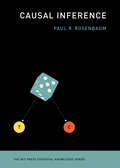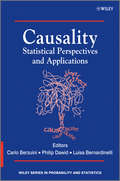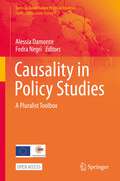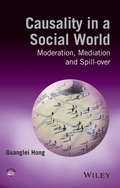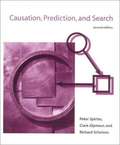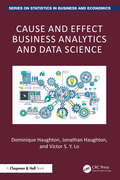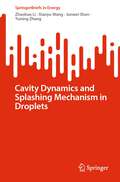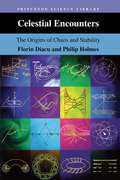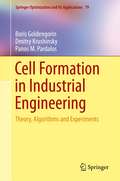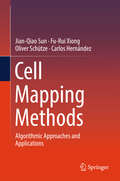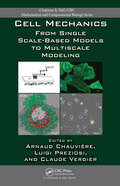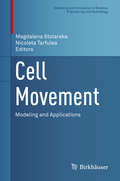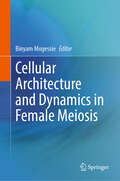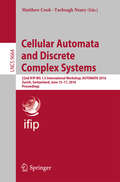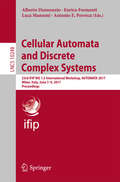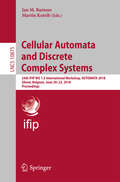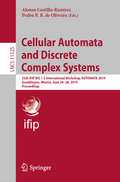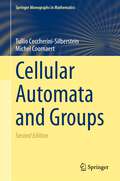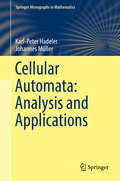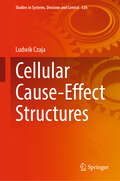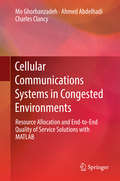- Table View
- List View
Causal Inference: An Introduction To Causal Inference (The MIT Press Essential Knowledge series)
by Paul R. RosenbaumA nontechnical guide to the basic ideas of modern causal inference, with illustrations from health, the economy, and public policy.Which of two antiviral drugs does the most to save people infected with Ebola virus? Does a daily glass of wine prolong or shorten life? Does winning the lottery make you more or less likely to go bankrupt? How do you identify genes that cause disease? Do unions raise wages? Do some antibiotics have lethal side effects? Does the Earned Income Tax Credit help people enter the workforce? Causal Inference provides a brief and nontechnical introduction to randomized experiments, propensity scores, natural experiments, instrumental variables, sensitivity analysis, and quasi-experimental devices. Ideas are illustrated with examples from medicine, epidemiology, economics and business, the social sciences, and public policy.
Causal Inference: The Mixtape
by Scott CunninghamAn accessible and contemporary introduction to the methods for determining cause and effect in the social sciences Causal inference encompasses the tools that allow social scientists to determine what causes what. Economists—who generally can’t run controlled experiments to test and validate their hypotheses—apply these tools to observational data to make connections. In a messy world, causal inference is what helps establish the causes and effects of the actions being studied, whether the impact (or lack thereof) of increases in the minimum wage on employment, the effects of early childhood education on incarceration later in life, or the introduction of malaria nets in developing regions on economic growth. Scott Cunningham introduces students and practitioners to the methods necessary to arrive at meaningful answers to the questions of causation, using a range of modeling techniques and coding instructions for both the R and Stata programming languages.
Causality
by Philip Dawid Carlo Berzuini Luisa BernardinellA state of the art volume on statistical causalityCausality: Statistical Perspectives and Applications presents a wide-ranging collection of seminal contributions by renowned experts in the field, providing a thorough treatment of all aspects of statistical causality. It covers the various formalisms in current use, methods for applying them to specific problems, and the special requirements of a range of examples from medicine, biology and economics to political science.This book:Provides a clear account and comparison of formal languages, concepts and models for statistical causality. Addresses examples from medicine, biology, economics and political science to aid the reader's understanding. Is authored by leading experts in their field. Is written in an accessible style.Postgraduates, professional statisticians and researchers in academia and industry will benefit from this book.
Causality for Artificial Intelligence: From a Philosophical Perspective
by Jordi VallverdúHow can we teach machine learning to identify causal patterns in data? This book explores the very notion of “causality”, identifying from a naturalistic and evolutionary perspective how living systems deal with causal relationships. At the same time, using this knowledge to identify the best ways to apply such biological models in machine learning scenarios. One of the more fundamental challenges for AI experts is to design machines that can understand the world, identifying the basic rules that govern reality. Statistics are powerful and fundamental for this process, but they are only one of the necessary tools. Counterfactual thinking is the other part of the necessary process that will help machines to become intelligent. This book explains the paths that can lead to algorithmic causality. It is essential reading for those who are not afraid of thinking at the interface of various academic disciplines or fields (AI, machine learning, philosophy, neuroscience, anthropology, psychology, computer sciences), and who are interested in the analysis of causal thinking and the ways in which cognitive systems (natural or artificial) can act in order to understand their environment. Professor Vallverdú is currently working on biomimetic cognitive architectures and multicognitive systems. His research has explored two main areas: epistemology and cognition. Since his early Ph.D. research on epistemic controversies, he has analyzed several aspects of computational epistemology. His latest research has focused on the causal challenges of machine learning techniques, particularly deep learning. One of his most promising advances is statistics meets causal graph reasoning (via Directed Acyclic Graphs), which still has several conceptual paths that need to be explored and identified. Counterfactual reasoning is a fundamental part of these open debates, which are under the analysis of Prof. Vallverdú. His current research is supported as part of the following projects: GEHUCT and ICREA Acadèmia.
Causality in Policy Studies: a Pluralist Toolbox (Texts in Quantitative Political Analysis)
by Alessia Damonte Fedra NegriThis volume provides a methodological toolbox for conducting policy research. Recognizing that policy research spans various academic disciplines, each of which takes a different view on causality, the volume introduces a methodologically pluralistic approach to policy studies. Each chapter clarifies the research question that each technique can answer, the research design and data treatment that each technique requires for its results to be sound, the validity domain of its results, and the actual deployment of the technique through a replicable example. Techniques covered include quasi-experimental designs, approaches to account for selection bias and observed imbalances, directed acyclic graphs and structural equation models, Qualitative Comparative Analysis, Bayesian case study and process tracing, and Agent-Based Modelling. By working through the volume, readers will understand how to learn from different techniques, apply them consciously, and triangulate them to make better sense of findings. This volume is intended for advanced academic courses, as well as scholars and practitioners in policy-related fields, such as political science, economics, sociology, and public administration. This is an open access book.
Causality in a Social World
by Guanglei HongCausality in a Social World introduces innovative new statistical research and strategies for investigating moderated intervention effects, mediated intervention effects, and spill-over effects using experimental or quasi-experimental data. The book uses potential outcomes to define causal effects, explains and evaluates identification assumptions using application examples, and compares innovative statistical strategies with conventional analysis methods. Whilst highlighting the crucial role of good research design and the evaluation of assumptions required for identifying causal effects in the context of each application, the author demonstrates that improved statistical procedures will greatly enhance the empirical study of causal relationship theory. Applications focus on interventions designed to improve outcomes for participants who are embedded in social settings, including families, classrooms, schools, neighbourhoods, and workplaces.
Causality: The p-adic Theory (STEAM-H: Science, Technology, Engineering, Agriculture, Mathematics & Health)
by Vladimir AnashinThis book delves into the mathematical theory of causal functions over discrete time, offering a fresh perspective on causality beyond its philosophical roots. By exploring the intricate world of p-adic 1-Lipschitz functions, this volume bridges the gap between abstract mathematical concepts and their practical applications in fields such as automata theory, combinatorics, and applied computer science. Readers will uncover a wealth of insights as the book investigates key topics including the nature of causal functions, the role of discrete time in causality, and the application of non-Archimedean metrics. With contributions from eminent scholars, this work invites readers to ponder critical questions: How do we define causality in mathematical terms? What are the implications of using p-adic analysis in understanding complex systems especially quantum ones? The author's unique approach makes this book an essential read for anyone interested in the intersection of mathematics and real-world applications. Ideal for researchers and practitioners with a background in mathematics, computer science, or physics, this book is a valuable resource for those seeking to deepen their understanding of causal functions. Whether you're a scholar exploring theoretical perspectives or a professional looking to apply these concepts practically, this volume offers a comprehensive guide to navigating the complexities of causality. Part of an ongoing series on advanced mathematical theories, it is an indispensable addition to any academic library.
Causation, Prediction, and Search
by Peter Spirtes Clark Glymour Richard ScheinesWhat assumptions and methods allow us to turn observations into causal knowledge, and how can even incomplete causal knowledge be used in planning and prediction to influence and control our environment? In this book Peter Spirtes, Clark Glymour, and Richard Scheines address these questions using the formalism of Bayes networks, with results that have been applied in diverse areas of research in the social, behavioral, and physical sciences. The authors show that although experimental and observational study designs may not always permit the same inferences, they are subject to uniform principles. They axiomatize the connection between causal structure and probabilistic independence, explore several varieties of causal indistinguishability, formulate a theory of manipulation, and develop asymptotically reliable procedures for searching over equivalence classes of causal models, including models of categorical data and structural equation models with and without latent variables. The authors show that the relationship between causality and probability can also help to clarify such diverse topics in statistics as the comparative power of experimentation versus observation, Simpson's paradox, errors in regression models, retrospective versus prospective sampling, and variable selection. The second edition contains a new introduction and an extensive survey of advances and applications that have appeared since the first edition was published in 1993.
Cause and Effect Business Analytics and Data Science (Chapman and Hall/CRC Series on Statistics in Business and Economics)
by Jonathan Haughton Dominique Haughton Victor S. LoAmong the most important questions that businesses ask are some very simple ones: If I decide to do something, will it work? And if so, how large are the effects? To answer these predictive questions, and later base decisions on them, we need to establish causal relationships.Establishing and measuring causality can be difficult. This book explains the most useful techniques for discerning causality and illustrates the principles with numerous examples from business. It discusses randomized experiments (aka A/B testing) and techniques such as propensity score matching, synthetic controls, double differences, and instrumental variables. There is a chapter on the powerful AI approach of Directed Acyclic Graphs (aka Bayesian Networks), another on structural equation models, and one on time-series techniques, including Granger causality.At the heart of the book are four chapters on uplift modeling, where the goal is to help firms determine how best to deploy their resources for marketing or other interventions. We start by modeling uplift, discuss the test-and-learn process, and provide an overview of the prescriptive analytics of uplift.The book is written in an accessible style and will be of interest to data analysts and strategists in business, to students and instructors of business and analytics who have a solid foundation in statistics, and to data scientists who recognize the need to take seriously the need for causality as an essential input into effective decision-making.
Cavity Dynamics and Splashing Mechanism in Droplets (SpringerBriefs in Energy)
by Xiaoyu Wang Yuning Zhang Zhaohao Li Junwei ShenThis brief explores the pivotal realm of droplet cavitation, a subject of great significance for enhancing fuel atomization and improving various industrial processes. The authors employ high-speed photography experiments, analyze bubble dynamics equations, and utilize numerical simulations to explore the dynamic behavior of cavitation bubbles and droplets. The book analyzes the entire lifecycle of cavitation bubbles, their interactions with different liquid droplets, and the key parameters governing their oscillation and collapse and sheds light on the collapse mechanisms and shock wave propagation influenced by liquid droplets. Additionally, it investigates the dynamics of droplet spattering by categorizing spatter patterns under diverse conditions, discusses the critical stability of droplet surfaces, and reveals the mechanisms by which cavitation bubble collapses induce droplet breakage. Taking vapor bubbles and diesel droplets as examples, the dynamic characteristics of specific droplets containing bubbles are also analyzed. This book offers an in-depth understanding of these phenomena with practical implications for a wide range of industrial applications and is a useful tool for researchers and engineers working in the fields of fluid dynamics, combustion engineering, and atomization processes.
Celestial Encounters: The Origins of Chaos and Stability (Princeton Science Library)
by Florin Diacu Philip HolmesCelestial Encounters is for anyone who has ever wondered about the foundations of chaos. In 1888, the 34-year-old Henri Poincaré submitted a paper that was to change the course of science, but not before it underwent significant changes itself. "The Three-Body Problem and the Equations of Dynamics" won a prize sponsored by King Oscar II of Sweden and Norway and the journal Acta Mathematica, but after accepting the prize, Poincaré found a serious mistake in his work. While correcting it, he discovered the phenomenon of chaos. Starting with the story of Poincaré's work, Florin Diacu and Philip Holmes trace the history of attempts to solve the problems of celestial mechanics first posed in Isaac Newton's Principia in 1686. In describing how mathematical rigor was brought to bear on one of our oldest fascinations--the motions of the heavens--they introduce the people whose ideas led to the flourishing field now called nonlinear dynamics. In presenting the modern theory of dynamical systems, the models underlying much of modern science are described pictorially, using the geometrical language invented by Poincaré. More generally, the authors reflect on mathematical creativity and the roles that chance encounters, politics, and circumstance play in it.
Cell Formation in Industrial Engineering: Theory, Algorithms and Experiments (Springer Optimization and Its Applications #79)
by Panos M. Pardalos Boris Goldengorin Dmitry KrushinskyThis book focuses on a development of optimal, flexible, and efficient models and algorithms for cell formation in group technology. Its main aim is to provide a reliable tool that can be used by managers and engineers to design manufacturing cells based on their own preferences and constraints imposed by a particular manufacturing system. This tool could potentially lower production costs by minimizing other costs in a number of areas, thereby increasing profit in a manufacturing system. In the volume, the cell formation problem is considered in a systematic and formalized way, and several models are proposed, both heuristic and exact. The models are based on general clustering problems, and are flexible enough to allow for various objectives and constraints. The authors also provide results of numerical experiments involving both artificial data from academic papers in the field and real manufacturing data to certify the appropriateness of the models proposed. The book was intended to suit the broadest possible audience, and thus all algorithmic details are given in a detailed description with multiple numerical examples and informal explanations are provided for the theoretical results. In addition to managers and industrial engineers, this book is intended for academic researchers and students. It will also be attractive to many theoreticians, since it addresses many open problems in computer science and bioinformatics.
Cell Mapping Methods: Algorithmic Approaches and Applications (Nonlinear Systems And Complexity Ser. #99)
by Carlos Hernández Jian-Qiao Sun Oliver Schütze Fu-Rui XiongThis book presents the latest algorithmic developments in the cell-mapping method for the global analysis of nonlinear dynamic systems, global solutions for multi-objective optimization problems, and global solutions for zeros of complex algebraic equations. It also discusses related engineering and scientific applications, including the nonlinear design of structures for better vibration resistance and reliability; multi-objective, structural-acoustic design for sound abatement; optimal multi-objective design of airfoils for better lift; and optimal multi-objective design of linear and nonlinear controls with or without time delay.The first book on the subject to include extensive Matlab and C++ codes, it presents various implementation algorithms of the cell-mapping method, enabling readers to understand how the method works and its programming aspects. A link to the codes on the Springer website will be provided to the readers.
Cell Mechanics: From Single Scale-Based Models to Multiscale Modeling
by Claude Verdier Arnaud Chauvière Luigi PrezigsiUbiquitous and fundamental in cell mechanics, multiscale problems can arise in the growth of tumors, embryogenesis, tissue engineering, and more. Cell Mechanics: From Single Scale-Based Models to Multiscale Modeling brings together new insight and research on mechanical, mathematical, physical, and biological approaches for simulating the behavior
Cell Movement: Modeling and Applications (Modeling and Simulation in Science, Engineering and Technology)
by Magdalena Stolarska Nicoleta TarfuleaThis book contains a collection of original research articles and review articles that describe novel mathematical modeling techniques and the application of those techniques to models of cell motility in a variety of contexts. The aim is to highlight some of the recent mathematical work geared at understanding the coordination of intracellular processes involved in the movement of cells. This collection will benefit researchers interested in cell motility as well graduate students taking a topics course in this area.
Cellular Architecture and Dynamics in Female Meiosis
by Binyam MogessieThis book brings together a diverse and exciting group of emerging and leading experts in female meiosis, each contributing a chapter that summarizes seminal recent progresses in their area of specialty. With various meiosis topics ranging from cytoskeletal function in worms to studies of oocyte meiosis in large mammals, this collection is intended for fundamental cell biologists interested the basic mechanisms of cell division and differentiation.
Cellular Automata And Complexity: Collected Papers
by Stephen WolframAre mathematical equations the best way to model nature? For many years it had been assumed that they were. But in the early 1980s, Stephen Wolfram made the radical proposal that one should instead build models that are based directly on simple computer programs. Wolfram made a detailed study of a class of such models known as cellular automata, and discovered a remarkable fact: that even when the underlying rules are very simple, the behaviour they produce can be highly complex, and can mimic many features of what we see in nature. And based on this result, Wolfram began a program of research to develop what he called A Science of Complexity."The results of Wolfram's work found many applications, from the so-called Wolfram Classification central to fields such as artificial life, to new ideas about cryptography and fluid dynamics. This book is a collection of Wolfram's original papers on cellular automata and complexity. Some of these papers are widely known in the scientific community others have never been published before. Together, the papers provide a highly readable account of what has become a major new field of science, with important implications for physics, biology, economics, computer science and many other areas.
Cellular Automata and Discrete Complex Systems: 22nd IFIP WG 1.5 International Workshop, AUTOMATA 2016, Zurich, Switzerland, June 15-17, 2016, Proceedings (Lecture Notes in Computer Science #9664)
by Matthew Cook Turlough NearyThis volume constitutes the thoroughly refereed proceedings of the 22nd IFIP WG 1. 5 International Workshop on Cellular Automata and Discrete Complex Systems, AUTOMATA 2016, held in Zurich, Switzerland, in June 2016. This volume contains 3 invited talks in full-paper length and 12 regular papers, which were carefully reviewed and selected from a total of 23 submissions. The papers feature research on all fundamental aspects of cellular automata and related discrete complex systems and deal with the following topics: dynamical, topological, ergodic and algebraic aspects; algorithmic and complexity issues; emergent properties; formal language processing; symbolic dynamics; models of parallelism and distributed systems; timing schemes; phenomenological descriptions; scientific modeling; and practical applications.
Cellular Automata and Discrete Complex Systems: 23rd IFIP WG 1.5 International Workshop, AUTOMATA 2017, Milan, Italy, June 7-9, 2017, Proceedings (Lecture Notes in Computer Science #10248)
by Enrico Formenti Alberto Dennunzio Luca Manzoni Antonio E. PorrecaThis volume constitutes the thoroughly refereed proceedings of the 23rd IFIP WG 1. 5 International Workshop on Cellular Automata and Discrete Complex Systems, AUTOMATA 2017, held in Milan, Italy, in June 2017. The 14 full papers presented together with one full-length invited paper and 2 invited talk abstracts were carefully reviewed and selected from a total of 28 submissions. The papers feature research on correlated models of automata. The topics include aspects and features of such models: dynamics; topological, ergodic, and algebraic aspects; algorithmic and complexity issues; emergent properties; formal languages; symbolic dynamics; tilings; models of parallelism and distributed systems; timing schemes; synchronous versus asynchronous models; phenomenological descriptions; scientific modelling; practical applications.
Cellular Automata and Discrete Complex Systems: 24th IFIP WG 1.5 International Workshop, AUTOMATA 2018, Ghent, Belgium, June 20–22, 2018, Proceedings (Lecture Notes in Computer Science #10875)
by Jan M. Baetens Martin KutribThis volume constitutes the thoroughly refereed proceedings of the 24th IFIP WG 1.5 International Workshop on Cellular Automata and Discrete Complex Systems, AUTOMATA 2018, held in Ghent, Belgium, in June 2018.The 10 regular papers presented in this book were carefully reviewed and selected from a total of 16 submissions. The papers highlight the major advances in the field and the development of new tools, support the development of theory and applications of CA and DCS and identify and study within an inter- and multidisciplinary context, the important fundamental aspects, concepts, notions and problems concerning CA and DCS.
Cellular Automata and Discrete Complex Systems: 25th IFIP WG 1.5 International Workshop, AUTOMATA 2019, Guadalajara, Mexico, June 26–28, 2019, Proceedings (Lecture Notes in Computer Science #11525)
by Alonso Castillo-Ramirez Pedro P. B. de OliveiraThis volume constitutes the refereed proceedings of the 25th IFIP WG 1.5 International Workshop on Cellular Automata and Discrete Complex Systems, AUTOMATA 2019, held in Guadalajara, Mexico, in June 2019.The 7 regular papers presented in this book were carefully reviewed and selected from a total of 10 submissions. The topics of the conference include deal with dynamical, topological, ergodic and algebraic aspects of CA and DCS, algorithmic and complexity issues, emergent properties, formal languages, symbolic dynamics, tilings, models of parallelism and distributed systems, timing schemes, synchronous versus asynchronous models, phenomenological descriptions, scientic modeling, and practical applications.
Cellular Automata and Groups (Springer Monographs in Mathematics)
by Tullio Ceccherini-Silberstein Michel CoornaertThis unique book provides a self-contained exposition of the theory of cellular automata on groups and explores its deep connections with recent developments in geometric and combinatorial group theory, amenability, symbolic dynamics, the algebraic theory of group rings, and other branches of mathematics and theoretical computer science. The topics treated include the Garden of Eden theorem for amenable groups, the Gromov–Weiss surjunctivity theorem, and the solution of the Kaplansky conjecture on the stable finiteness of group rings for sofic groups. Entirely self-contained and now in its second edition, the volume includes 10 appendices and more than 600 exercises, the solutions of which are presented in the companion book Exercises in Cellular Automata and Groups (2023) by the same authors. It will appeal to a large audience, including specialists and newcomers to the field.
Cellular Automata: Analysis and Applications
by Johannes Müller Karl-Peter HadelerThis book provides an overview of the main approaches used to analyze the dynamics of cellular automata. Cellular automata are an indispensable tool in mathematical modeling. In contrast to classical modeling approaches like partial differential equations, cellular automata are relatively easy to simulate but difficult to analyze. In this book we present a review of approaches and theories that allow the reader to understand the behavior of cellular automata beyond simulations. The first part consists of an introduction to cellular automata on Cayley graphs, and their characterization via the fundamental Cutis-Hedlund-Lyndon theorems in the context of various topological concepts (Cantor, Besicovitch and Weyl topology). The second part focuses on classification results: What classification follows from topological concepts (Hurley classification), Lyapunov stability (Gilman classification), and the theory of formal languages and grammars (Kůrka classification)? These classifications suggest that cellular automata be clustered, similar to the classification of partial differential equations into hyperbolic, parabolic and elliptic equations. This part of the book culminates in the question of whether the properties of cellular automata are decidable. Surjectivity and injectivity are examined, and the seminal Garden of Eden theorems are discussed. In turn, the third part focuses on the analysis of cellular automata that inherit distinct properties, often based on mathematical modeling of biological, physical or chemical systems. Linearity is a concept that allows us to define self-similar limit sets. Models for particle motion show how to bridge the gap between cellular automata and partial differential equations (HPP model and ultradiscrete limit). Pattern formation is related to linear cellular automata, to the Bar-Yam model for the Turing pattern, and Greenberg-Hastings automata for excitable media. In addition, models for sand piles, the dynamics of infectious d
Cellular Cause-Effect Structures (Studies in Systems, Decision and Control #526)
by Ludwik CzajaThis book presents the adaptation of cause-effect structures to the formal description of phenomena such as the behaviour of living objects, the mutual communication of living cells, but also such as the growth of crystals and other natural processes. The system of cause-effect structures has been designed for the description and analysis of objects with dispersed components, acting concurrently and synchronizing and communicating one another. This adaptation consists in customizing generic semantics of cause-effect structures to semantics specific to the behaviour of natural objects. That is creating evolution rules for the formal models of these objects. However, the structural, algebraic properties of cause-effect structures are retained. The activity of cellular cause-effect structures is supposed to imitate the activity of cellular automata, the formal system intended for the above-mentioned aims. But operations on syntactic constructions, in particular their transformations and simplification, are the same as for the general cause-effect structures. These algebraic operations are also used to perform certain geometric/topological conversions of location bases for the cellular cause-effect structures, like flat surfaces into cylindrical or toroidal. This is depicted by numerous illustrations. An adaptation of cause-effect structures to other formal descriptions of some natural phenomena, such as reaction systems, is provided in book 331 of the “Lecture Notes in Networks and Systems” series, whereas the complete description of cause-effect structures, in book 45.
Cellular Communications Systems in Congested Environments: Resource Allocation and End-to-End Quality of Service Solutions with MATLAB
by Ahmed Abdelhadi Mo Ghorbanzadeh Charles ClancyThis book presents a mathematical treatment of the radio resource allocation of modern cellular communications systems in contested environments. It focuses on fulfilling the quality of service requirements of the living applications on the user devices, which leverage the cellular system, and with attention to elevating the users' quality of experience. The authors also address the congestion of the spectrum by allowing sharing with the band incumbents while providing with a quality-of-service-minded resource allocation in the network. The content is of particular interest to telecommunications scheduler experts in industry, communications applications academia, and graduate students whose paramount research deals with resource allocation and quality of service.
